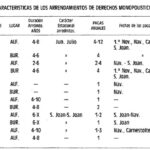
During the Ancien Régime, monopoly rights constituted one of the fundamental pillars of the seigniorial regime. The author shows how monopolies were produced in two Valencian manors, Alfara and Burjasot. The most common places where this right was applied were in the mill, oven, butcher’s shop and orchard. Lease contracts were usually short term; between 4 and 10 years at their longest. In turn, payment was stipulated in annual instalments, although depending on the leased property, these payments could be paid in different numbers: from monthly payments for some mills, to single payments for butcheries, orchards or shops. With monopoly rights, tenants were assured of fixed rents, although this had a negative impact on the development of productive forces as the feudal organisation of production stagnated.
Collection: Statistics
Project: 3. Rural world and urban world in the formation of the European identity., 4. Family, daily life and social inequality in Europe.
Chronology: XVII
Scope: Secondary Education, Baccalaureate, University
Link: https://rua.ua.es/dspace/bitstream/10045/5100/1/RHM_02_02.pdf
Resource type: Statistics
Format: Table
Source: Andrés Robres, F. (1982). "Los derechos de monopolio en la Valencia del Antiguo Régimen: el ejemplo de Alfara y Burjasot durante el siglo XVIII", en Revista de Historia Moderna. Anales de la Universidad de Alicante, nº 2, p. 28.
Language: Spanish
Date: 1982
Owner: Pablo Ballesta Fernández (Modernalia)
Copyright: ©Revista de Historia Moderna ©Fernando Andrés Robres
Abstract: Resource showing the characteristics of monopoly rights in the Valencian lordships of Alfara and Burjasot during the 17th century
Image
Tags







